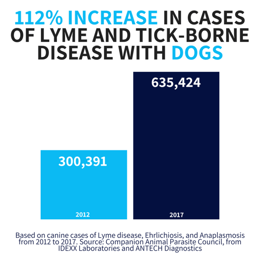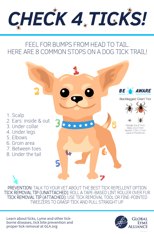
 Marisol and Rob Thomas, through their organization Sidewalk Angels Foundation (SWA), and Global Lyme Alliance (GLA) have joined forces to share the importance of protecting your entire family from Lyme and other tick-borne diseases. Through this partnership, SWA and GLA look to raise awareness about the real and everyday risk of contracting Lyme disease and promote prevention methods for all members of your family. We are all at risk of Lyme disease, regardless of how many legs or how much fur we have.
Marisol and Rob Thomas, through their organization Sidewalk Angels Foundation (SWA), and Global Lyme Alliance (GLA) have joined forces to share the importance of protecting your entire family from Lyme and other tick-borne diseases. Through this partnership, SWA and GLA look to raise awareness about the real and everyday risk of contracting Lyme disease and promote prevention methods for all members of your family. We are all at risk of Lyme disease, regardless of how many legs or how much fur we have.  Cases of Lyme disease continue to skyrocket, as a result of more ticks in more regions. For people, cases have doubled over the last 10 years; for dogs, it’s doubled over the last five years. A single tick-bite can be debilitating, and in rare cases, deadly. With no accurate diagnostic test and no proven treatment, prevention is critical. It’s crucial we take steps to protect ourselves and our pets. Here are two ways you can help curb the escalating rate of Lyme and other tick-borne diseases, for yourself and others:
Cases of Lyme disease continue to skyrocket, as a result of more ticks in more regions. For people, cases have doubled over the last 10 years; for dogs, it’s doubled over the last five years. A single tick-bite can be debilitating, and in rare cases, deadly. With no accurate diagnostic test and no proven treatment, prevention is critical. It’s crucial we take steps to protect ourselves and our pets. Here are two ways you can help curb the escalating rate of Lyme and other tick-borne diseases, for yourself and others:
- Prevention
- Donate
PREVENTION
 It’s critical to protect ‘both ends of the leash’ from tick bites, and the damaging, and sometimes deadly, pathogens they deliver. Here are a few, simple steps to take for both yourself and your canine family members. Tick Prevention Just as you put sunscreen on before time in the sun, or your seatbelt on before starting the car, get in the habit of applying on-skin tick repellent before you head outdoors. Picaridin-based repellents tend to last longer and have less toxicities. Learn about different repellent ingredients here, to determine which is best for your family and lifestyle. It’s important to always Be Tick AWARE when going outside.
It’s critical to protect ‘both ends of the leash’ from tick bites, and the damaging, and sometimes deadly, pathogens they deliver. Here are a few, simple steps to take for both yourself and your canine family members. Tick Prevention Just as you put sunscreen on before time in the sun, or your seatbelt on before starting the car, get in the habit of applying on-skin tick repellent before you head outdoors. Picaridin-based repellents tend to last longer and have less toxicities. Learn about different repellent ingredients here, to determine which is best for your family and lifestyle. It’s important to always Be Tick AWARE when going outside.
AVOID areas where ticks live. Ticks thrive in wood piles, long grass, leaf piles, and beach grass.
WEAR light-colored clothing: long pants, sleeves, socks, and closed-toe shoes.
APPLY EPA-approved tick repellent (such as DEET or picaridin) to skin and insecticide (such as permethrin) to clothing and shoes as directed.
REMOVE clothing upon entering the home; toss into dryer at high temperature for 10-15 minutes.
EXAMINE yourself and your pets for ticks daily. Check everywhere — ticks love to hide!
Tips to Keep Your Dog Safe from Ticks- Keep grass mowed and remove leaf piles
- Discuss tick prevention options and repellents with your veterinarian
- Check your dog for ticks daily—especially their ears, eyes, eyelids, muzzle, paws, neck, under the tail, and groin
- Be mindful of Lyme symptoms.
DONATE
 Support SWA and GLA’s partnership to protect families from Lyme and other tick-borne diseases. Your donation will support our awareness and prevention programs for people and pets.
Support SWA and GLA’s partnership to protect families from Lyme and other tick-borne diseases. Your donation will support our awareness and prevention programs for people and pets.

GLA
Admin at GLA
